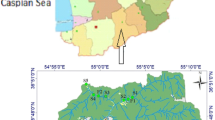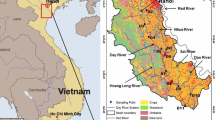Abstract
Stable nitrogen isotope ratios (δ15N) of freshwater mussels from a series of lakes and ponds wererelated to watershed land use characteristics to assess their utility in determining the source ofnitrogen inputs to inland water bodies. Nitrogen isotope ratiosmeasured in freshwater musselsfrom 19 lakes and ponds in Rhode Island, U.S.A., ranged from4.9–12.6‰ and were found tosignificantly correlate with the fraction of residential development in 100 and 200 m bufferzones around the ponds. Mussel δ15N values in 12 of the 19 ponds also showed significantcorrelation with average dissolved nitrate concentrations, which ranged from 23–327 μg L-1.These observations, in light of previous studies which link elevatedδ15N values of nitrogenderived from septic wastewater with those seen in biota, suggest that mussel isotope ratios mayreflect nitrogen source in freshwater ecosystems. We followed aniterative approach usingmultiple regression analysis to assess the relationship between musselδ15N and the land usecategories fraction residential development, fraction feedlotagriculture, fraction row-cropagriculture, and fraction natural vegetation in 100 and 200 m bufferzones and pond watersheds.From this we developed a simple regression model to predict musselδ15N from the fraction ofresidential development in the 200 m buffer zone around the pond.Subsequent testing with datafrom 16 additional sites in the same ecoregion led us to refine themodel by incorporating thefraction of natural vegetation. The overall average absolute differencebetween measured andpredicted δ15N values using the two-parameter model was 1.6‰. Potential sources of error inthe model include differences in the scale and categorization ofland-use data used to generate andtest the model, differences in physical characteristics, such asretention time and range ofresidential development, and exclusion of sources of enrichednitrogen such as runoff from feedlot operations or increased nitrogen loading from inefficient or failed septic systems.
Similar content being viewed by others
References
Aguilar, C., Fogel, M. L. and Paerl, H. W.: 1999, ‘Dynamics of atmospheric combined inorganic nitrogen utilization in the coastal waters of North Carolina’ ,Mar. Ecol. Prog. Ser. 180, 65–79.
Anderson, J. R., Hardy, E. E., Roach, J. T. and Whitmer, R. E.: 1976, ‘A Land Use and Land Cover Classification System for Use with Remote Sensor Data’ ,Geological Survey Professional Paper 964, U.S. Geological Survey, Washington, D.C.
Aravena, R., Evans, M. L. and Cherry J. A.: 1993, ‘Stable isotopes of oxygen and nitrogen in source identification of nitrate from septic systems’ ,Ground Water 31, 180–186.
Brinson, M. M., Bradshaw, H. D. and Kane, E. S.: 1984, ‘Nutrient assimilative capacity of an alluvial floodplain swamp’ ,J. Appl. Ecol. 21, 1041–1057.
Cabana, G. and Rasmussen, J. B.: 1994, ‘Modelling food chain structure and contaminant bioaccumulation using stable nitrogen isotopes’ ,Nature 372, 255–257.
Cabana, G. and Rasmussen, J. B.: 1996, ‘Comparison of Aquatic Food Chains Using Nitrogen Isotopes’ ,Proceedings of the National Academy of Sciences USA 93, 10844–10847.
Carpenter, S. R., Bolgrien, D., Lathrop, R. C., Stowe, C. A. and Reed, T.: 1998, ‘Ecological and economic analysis of lake eutrophication by non-point source pollution’ ,Austr. J. Ecol. 23, 68–79.
Cifuentes, L. A., Coffin, R. B., Solorzano, W. C., Espinoza, J. and Twilley, R. R.: 1996, ‘Isotopic and elemental variations of carbon and nitrogen in a mangrove estuary’ ,Estuarine, Coast. Shelf Sci. 43, 781–800.
Correll, D. L. and Weller, D. E.: 1989, ‘Factors Limiting Processes in Freshwater Wetlands: An Agricultural Primary Stream Riparian Forest’, in R. R. Scharitz and J. W. Gibbons (eds), Freshwater Wetlands and Wildlife, Department of Energy Symposium Series Number 61, Oak Ridge, Tennessee, pp. 9–23.
Correll, D. L., Jordan, T. E. and Weller, D. E.: 1992, ‘Nutrient flux in a landscape: Effects of coastal land use and terrestrial community mosaic on nutrient transport to coastal waters’ ,Estuaries 15, 431–442.
Cotteral, J. A. and Norris, D. P.: 1969, ‘Septic tank system’ ,J. Sanit. Engin. Div. Amer. Soc. Civil Engin. 95, 715–746.
DeNiro, M. J. and Epstein, S.: 1981, ‘Influence of diet on the distribution of nitrogen isotopes in animals’ ,Geochim. Cosmochim. Acta 45, 341–351.
Downing, J. A. and McCauley, E.: 1992, ‘The nitrogen:phosphorous relationship in lakes’ ,Limnol. Ocean. 37, 936–945.
Fourqurean, J. W., Moore, T. O., Fry, B. and Hollibaugh, J. T.: 1997, ‘Spatial and temporal variation in C:N:P ratios, δ 15N and δ 13C of eelgrass Zostera marina as indicators of ecosystem processes, Tomales Bay, California’ ,Mar. Ecol. Progr. Ser. 157, 147–157.
Forsberg, C.: 1977, ‘Nitrogen as a growth factor in fresh water’ ,Mar. Ecol. Progr. Ser. 8, 275–290.
Freyer, H. D. and Aly, A. I. M.: 1974, ‘Nitrogen – 15 variations infertilizernitrogen’ ,J. Environ. Qual. 3, 405–406.
Fry, B.: 1988, ‘Food web structure on Georges Bank from stable C, N, and S isotopic compositions’ ,Limnol. Ocean. 33, 1182–1190.
Fry, B.: 1999, ‘Using stable isotopes to monitor watershed influences on aquatic trophodynamics’ ,Can. J. Fish. Aquat. Sci. 56, 2167–2171.
Gormley, J. R. and Spalding, R. F.: 1979, ‘Sources and concentrations of nitrate-nitrogen in groundwater of the central Platte region, Nebraska’ ,Ground Water 17, 291–301.
Guthrie, R. C. and Stolgitis, J. A.: 1977, ‘Fisheries Investigations and Management in Rhode Island Lakes and Ponds’, Rhode Island Division of Fish and Wildlife, Fisheries Report No. 3, Providence, RI.
Hanten Jr., R. P., Neuman, R. M., Ward, S. M., Carley, R. J., Perkins, C. R. and Pirrie, R.: 1997, ‘Relationships Between Largemouth Bass Mercury Levels and Environmental Characteristics of Connecticut Lakes’, Connecticut Institute of Water Resources ERI/97-01, Storrs, CT.
Herron, E. M. and Green, L. T.: 1996, URI Watershed Watch: 1995, Contribution # 3395, College of Resource Development, University of Rhode Island, Kingston, RI.
Howarth, R. W., Marino, R. and Cole, J. J.: 1988, ‘Nitrogen fixation in freshwater, estuarine, and marine ecosystems. 2. Biogeochemical controls’ ,Limnol. Ocean. 33, 688–701.
Howarth, R. W., Billen, G., Swaney, D., Townsend, A., Jaworski, N., Lajtha, K. et al.: 1996, ‘Regional nitrogen budgets and riverine N and P fluxes for the drainage to the North Atlantic Ocean: Natural and human influences’ ,Biogeochem. 35, 75–139.
Jansson, M., Andersson, R., Berggren, H. and Leonardson, L.: 1994, ‘Wetland and lakes as nitrogen traps’ ,Ambio 23, 320–325.
Jaervinen, M. and Salonen, K.: 1998, ‘Influence of changing food web structure on nutrient limitation of phytoplankton in a highly humic lake’ ,Can. J. Fish. Aquat. Sci. 55, 2562–2571.
Jordan, T. E., Correll, D. L. and Weller, D. E.: 1997, ‘Relating nutrient discharges from watersheds to land use and streamflow variability’ ,Water Resources Res. 33, 2579–2590.
Kreitler, C.W.: 1979, ‘Nitrogen isotope ratio study of soils and groundwater nitrate from alluvial fan aquifers in Texas’ ,J. Hydrol. 42, 147–170.
Kreitler, C. W. and Browning, L. A. 1983, ‘Nitrogen isotope ratio analysis of groundwater nitrate in carbonate aquifers: Natural sources versus human pollution’ ,J. Hydrol. 61, 285–301.
Kling, G. W. and Fry, B.: 1992, ‘Stable isotopes and planktonic trophic structure in arctic lakes’ ,Ecology 73, 561–566.
Lee, H. L. and DeAngelis, D. L.: 1997, ‘A simulation of the spatio-temporal dynamics of the unionid mussels’ ,Ecol. Model. 95, 171–180.
Macko, S. A. and Ostrum, N. E.: 1994, ‘Sources of Variation in the Stable Isotopic Composition of Plants’, in K. Lajtha and R. H. Michener (eds), Stable Isotopes in Ecology and Environmental Science, Blackwell Scientific Press, Boston, MA, pp. 45–62.
McClelland, J. W. and Valiela, I.: 1998, ‘Linking nitrogen in estuarine producers to land-derived sources’ ,Limnol. Ocean. 43, 577–585.
McClelland, J. W., Valiela, I. and Michener, R. H.: 1997, ‘Nitrogen-stable isotope signatures in estuarine food webs: A record of increasing urbanization in coastal watersheds’ ,Limnol. Ocean. 42, 930–937.
McKinney, R. A., Lake, J. L., Allen, M. and Ryba, S.: 1999, ‘Spatial variability in mussels used to assess base level nitrogen isotope ratio in freshwater ecosystems’ ,Hydrobiologia 412, 17–24.
McKinney, R. A., Nelson, W. S., Charpentier, M. and Wigand, C.: 2001, ‘Ribbed mussel nitrogen isotope signatures reflect nitrogen sources in coastal salt marshes’ ,Ecol. Appl. 11, 203–214.
McMahon, R. F.: 1991, ‘Mollusca: Bivalvia’, in J. H. Thorp and A. P. Covich (eds), Ecology and Classification of North American Freshwater Invertebrates, Academic Press, Harcourt, Brace Janovich, San Diego, CA, p. 367.
Minigawa, M. and Wada, E.: 1984, ‘Stepwise enrichment of 15N along food chains: Further evidence and the relation between δ 15N and animal age’ ,Geochim. Cosmochim. Acta 481, 1135–1140.
Morris, D. P. and Lewis Jr., W. M.: 1988, ‘Phytoplankton nutrient limitation in Colorado mountain lakes’ ,Freshwater Biol. 20, 315–327.
Omernik, J. M.: 1987, ‘Ecoregions of the conterminous United States’ ,Ann. Assoc. Amer. Geograph. 77, 118–125.
Reckhow, K. H.: 1988, ‘Empirical models for trophic state in southeastern U.S. lakes and reservoirs’ ,Water Resources Bull. 24, 723–734.
Schelske, C. L.: 1994, ‘Assessing nutrient limitation in a hypereutrophic lake’ ,Lake Reservoir Manage. 9, 112–119.
Schindler, D. W.: 1977, ‘Evolution of phosphorous limitation in lakes’ ,Science 195, 260–262.
Schindler, D. W.: 1985, ‘Interrelationships Between the Cycles of Elements in Freshwater Ecosystems’, in G. E. Likens (ed.), Some Perspectives of the Major Biogeochemical Cycles, SCOPE 17, John Wiley & Sons, New York, pp. 113–123.
Seitzinger, S. P.: 1988, ‘Denitrification in freshwater and coastal marine ecosystems: Ecological and geochemical significance’ ,Limnol. Ocean. 33, 702–724.
Sietman, B. E., Furman, M. A. and Pursell, F. A.: 1998, ‘Colonization of bedrock by freshwater mussels (Bivalvia: Unionidae)’ ,Amer. Midland Natural. 141, 209-211.
Smith, V. H.: 1990, ‘Phytoplankton Responses to Eutrophication in Inland Waters’, in I. Akatsuka (ed.), Introduction to Applied Phycology, SPB Academic Publishing, Amsterdam, pp. 231–249.
Smith, V. H.: 1998, ‘Cultural Eutrophication of Inland, Estuarine, and CoastalWaters’, in M. L. Pace and P. M. Groffman (eds), Successes, Limitations, and Frontiers in Ecosystem Science, Springer, New York, pp. 7–49.
Summer, R. M., Alonso, C. V. and Young, R. A.: 1990, ‘Modeling linked watershed and lake processes for water quality management decisions’ ,J. Environ. Qual. 19, 421–427.
USEPA: 1992, Compendium of watershed-scale Models for TMDL Development, EPA841-R-92-002, U.S. Environmental Protection Agency, Office of Water, Washington, D.C.
USEPA: 1994, National Water Quality Inventory, 1992 Report to Congress, EPA 841-R-94-001. U.S. Environmental Protection Agency, Office of Water, Washington, D.C.
Valiela, I., Collins, G., Kremer, J., Lajtha, K., Geist, M., Seely, B., Brawley. J. and Sham, C. H.: 1997, ‘Nitrogen loading from coastal watersheds to receiving estuaries: New method and application’ ,Ecol. Appl. 7, 358–380.
Valiela, I, Foreman, K., LaMontagne, M., Hersh, D., Costa, J., Peckol, P., DeMeo-Anderson, B., D'Avanzo, C., Babione, M., Sham, C. H., Brawley, J. and Lajtha, K.: 1992, ‘Couplings of watersheds and coastal waters: Sources and consequences of nutrient enrichment in Waquoit Bay, Massachusetts’ ,Estuaries 15, 443–457.
Vander Zanden, M. J. and Rasmussen, J. B.: 1999, ‘Primary consumer δ 13C and δ 15N and the trophic position of aquatic consumers’ ,Ecology 80, 1395–1404.
Vought, L. B.-M., Dahl, J., Lauge Pedersen, C. and Lacoursiere, J. O.: 1994, ‘Nutrient retention in riparian ecotones’ ,Ambio 23, 342–348.
Wada, E. and Hattori, A.: 1991, Nitrogen in the Sea: Forms, Abundances, and Rate Processes, CRC Press, Boston, MA, pp. 264–278.
Walker Jr., W. W.: 1984, ‘Empirical Prediction of Chlorophyll in Reservoirs’, in Lake and Reservoir Management, US EPA 440/5-84-001, Washington, D,C.
Yelenik, S., McClelland, J. W., Feinstein, N. and Valiela, I.: 1996, ‘Changes in N and C stable isotope signatures of particulate organic matter and ribbed mussels in estuaries subject to different nutrient loading’ ,Biol. Bull. 191, 329–330.
Yoshioka, T. and Wada, E.: 1994, ‘A stable isotope study on seasonal food web dynamics in a eutrophic lake’ ,Ecology 75, 835–846.
Author information
Authors and Affiliations
Corresponding author
Rights and permissions
About this article
Cite this article
McKinney, R.A., Lake, J.L., Charpentier, M.A. et al. Using Mussel Isotope Ratios to Assess Anthropogenic Nitrogen Inputs to Freshwater Ecosystems. Environ Monit Assess 74, 167–192 (2002). https://doi.org/10.1023/A:1013824220299
Issue Date:
DOI: https://doi.org/10.1023/A:1013824220299




